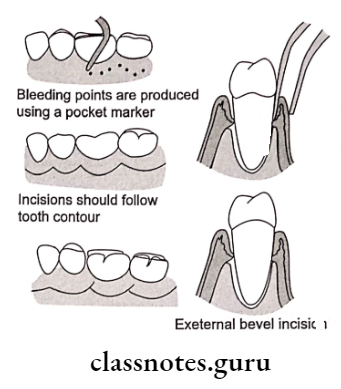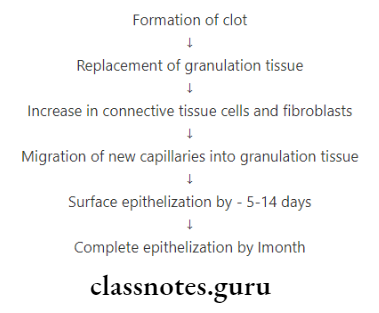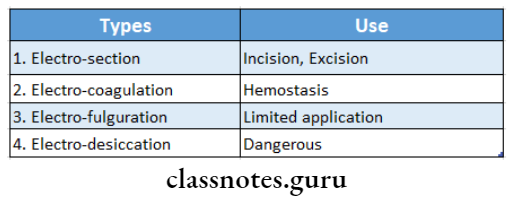Gingivectomy Important Notes
1. Indications of gingivectomy
- Elimination of supra bony pockets if the pocket wall is fibrous
- Elimination of gingival enlargements
- Elimination of supra bony periodontal abscess
2. Contra indications of gingivectomy
- The need for bone surgery or for examination of bone shape and morphology
- The bottom of the pocket is apical to the mucogingival junction
- Aesthetic regions
Read And Learn More: Periodontics Question and Answers
3. Disadvantages of gingivectomy
- Long time to heal
- Loss of attached gingiva
4. Electrosurgery
- It can be used for gingivectomy, gingivoplasty, relocation of frenal attachments, incisions of periodontal abscess, and periocoronal flaps
- It is not used for procedures that involve proximity to the bone
Gingivectomy Long Essays
Question 1. Define Gingivectomy. Describe indications, contraindications, and their types. Write a note on a surgical procedure.
Answer:
Gingivectomy:
- Excision of the soft tissue wall of the pocket
Gingivectomy Indications:
- Eliminate – Suprabony pocket
- Pseudo pockets
- Fibrous gingival enlargement
- Creates a physiological form of the gingiva
- Improves esthetics
- Creates bilateral symmetry
- Subgingival restoration
- Correction of gingival craters
Gingivectomy Contraindications:
- Thick bony ridges
- Poor oral hygiene
- Infrabony pockets
- Un-cooperative patients
- Dentinal hypersensitivity
- Medically compromised patients
Gingivectomy Types:
- Surgical
- Electrosurgery
- Laser
- Chemosurgery
Gingivectomy Surgical Gingivectomy Technique:


Gingivectomy Short Essays
Question 1. Electrosurgery.
Answer:
Electrosurgery Electrodes Used:
- Single wire
- Loop electrodes
- Heavy bulkier electrodes
- Frequency used-1.5-7.5 million cycles/second
Electrosurgery Indications:
- Gingival enlargements
- Gingivoplasty
- Frenectomy
- Periodontal abscess
- Periocoronal abscess
Electrosurgery Advantages:
- Adequate tissue contour
- Control of hemorrhage
Electrosurgery Disadvantages:
- Unpleasant odor
- Bone damage
- Tissue damage
Question 2. Gingivectomy
Answer:
Gingivectomy Definition:
- Gingivectomy is the excision of the soft tissue wall of the pocket
Gingivectomy Rationale:
- To provide good visibility and accessibility for complete calculus removal and thorough smoothening of roots
- To facilitate gingival healing by creating a favorable environment
- To restore physiological gingival contour
Gingivectomy Indications:
- Eliminates
- Suprabony pocket
- Pseudo pockets
- Fibrous gingival enlargements
- Creates a physiological form of the gingiva
- Improves esthetics
- Creates bilateral symmetry Subgingival restoration
- Correction of gingival craters
Gingivectomy Contraindications:
- Thick bony ridges
- Poor oral hygiene
- Infrabony pockets
- Un-cooperative patients
- Dentinal hypersensitivity
- Medically compromised patients
Gingivectomy Types:
- Surgical
- Electrosurgery
- Laser
- Chemosurgery
Gingivectomy Short Question And Answers
Question 1. Healing after surgical Gingivectomy.
Answer:
Gingivectomy Steps:

Question 2. Periodontal instruments for Gingivectomy.
Answer:
- Mouth mirror, probe
- Pocket markers
- Interdental knives
- Kirkland & Orban
- Surgical blade with BP handle
- Curettes
- Tissue forceps and scissors
- Periodontal dressing
Question 3. Types of Electrosurgical Techniques.
Answer:

Question 4. Gingivectomy by chemosurgery.
Answer:
- Gingivectomy can be done using chemicals such as 5% paraformaldehyde or potassium hydroxide
- It is not used nowadays because of many disadvantages
Chemosurgery Disadvantages:
- Depth of action cannot be controlled
- Injury to healthy attached tissue
- Gingival remodeling is not possible
- Delayed wound healing
- Slow epithelialization and reformation of junctional epithelium
Question 5. Electrosurgery.
Answer:
Electrosurgery is a technique in which electric current is used for incisions
Electrosurgery Indications:
- Gingival enlargement
- Gingivoplasty
- Frenectomy
- Periodontal abscess
- Pericoronal abscess
Electrosurgery Advantages:
- Adequate tissue contour
Gingivectomy Viva Voce
- Gingivectomy is not indicated in infra bony pockets
- After gingivectomy, complete epithelisation of the surgical wound is completed in about 1 month
- Connective tissue repair is completed in about 2 months
- The maximum flow of gingival fluid occurs 1 week after a gingivectomy
- Gingivectomy may be performed surgically by means of scalpels, electrodes, laser beams, or chemicals
- Gingivectomy incision apical to the pocket markings should be directed coronally
- Complete epithelial repair after gingivectomy takes about 1 month
- Complete repair of connective tissue after gingiva- tomy takes about 7 weeks
- GCF flow reached the maximum level after 7 days of gingivectomy
